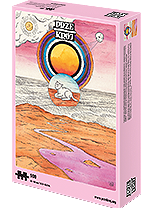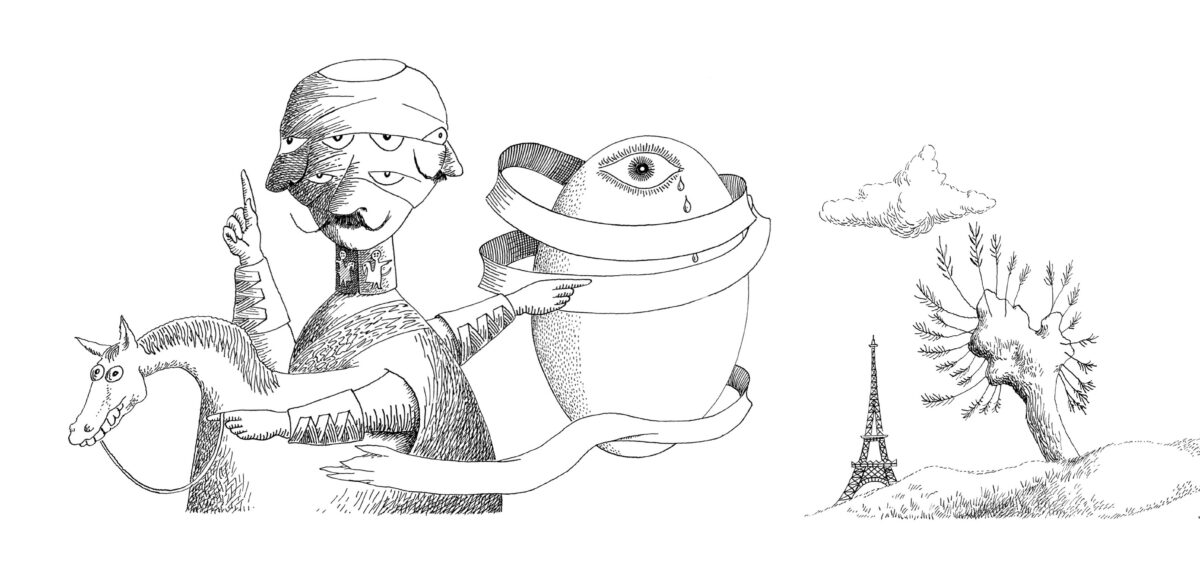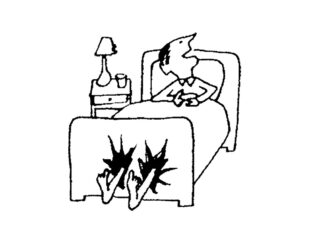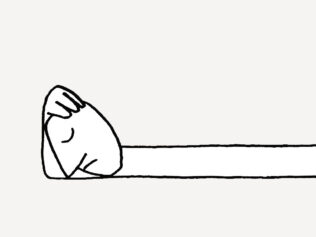
While lucid dreaming, we can influence what we dream of – and thus make our deepest fantasies come true. Some experience this state spontaneously, while others specifically practice it.
What is lucid dreaming all about? It is a state in which we experience a dream without losing access to our memory, will, and the other intellectual capacities we know in wakefulness. Additionally, the dream’s quality is, as it were, improved: colours are more intense, we perceive images and sounds more clearly. Most interestingly, however – and most temptingly – the dreamer is able to influence the content of the dream almost freely. This is accompanied by strong emotions, including euphoria (which sometimes makes people wake up).
In that state, then, theoretically we can see all our wishes come true. My observations lead me to believe that lucid dreamers usually try to indulge in two kinds of fantasies: sex and flying. Such was the case of two famous directors. In his book The Dance of Reality, Alejandro Jodorowsky described flying to the spirit world during his oneiric travels; there he would meet his late friend Roland Topor (intriguingly, according to Jodorowsky, Topor no longer creates macabre visions in the beyond, but realistic landscapes instead). Michel Gondry, the director of The Science of Sleep, among others, made a very French sort of admission that his lucid dreaming “usually ends in sex with the first woman I meet.”
Oneiric travellers from all around the world have developed a range of methods that assist in triggering a lucid dream. One of the most popular is to keep asking ourselves during the day whether we are sleeping – this is supposed to create a habit of questioning the reality of our perception, thanks to which our consciousness is able to become aware that it’s dreaming when we are asleep. It is vital to commit dreams to memory, pay attention to them and have a dream diary (apparently, it’s important to remember at least one dream every night). Reading the diary allows us to recognize motifs that recur in our dreams; knowing them allows us to realize that we’re dreaming. All oneironauts – that’s what practitioners of lucid dreaming are called – agree that the key thing is to nurture an intention to experience this state as we get ready for bed.
Lucid dreaming can be learned, and the more advanced the level, the easier it is to influence the dream’s content, duration, etc. But this state can also appear spontaneously. Research done in Austria in 1998 showed that 26% of participants had experienced lucid dreaming at least once in their life, regardless of education, religion or world view. There are also people for whom this state is natural, and who are perhaps surprised that others have to try so hard to achieve it.
Until recently, sceptics could freely mock such claims, because lucid dreaming had not been scientifically proven. How can we even prove such a phenomenon? How can I convince others that I am aware of the fact I am dreaming if I’m asleep? Psychologist Keith Hearne from the University of Hull found an impressively ingenious way of answering this question. In 1975, along with an advanced disciple of the art, Alan Worsley, he presented satisfying evidence based on the fact that during sleep muscles are essentially at rest, but with two exceptions: the diaphragm and the eyeballs still move. When Worsley, observed by Hearne and some cameras, became aware that he was dreaming and simultaneously attached to measuring apparatus, he moved his eyeballs from left to right eight times, as previously agreed. During that movement, the electroencephalograph showed increased mental activity in the dreamer. In 1978, a similar experiment was conducted, independently of the British, at Stanford University by Stephen LaBerge. This research was part of his PhD thesis, which was to confirm empirically the phenomenon of lucid dreaming.
Of course, the history of lucid dreaming isn’t limited only to the 1970s. The phenomenon has been known to humanity since time immemorial, and certain cultures have developed a whole suite of sophisticated techniques around it; they help not only to bring the state about, but also to make creative use of it. As we have mentioned, the possibilities opened up by lucid dreaming are almost limitless. If I can influence the form and content of the dream, I am able to travel to every place on Earth, but can also visit distant planets, encounter the dead, speak to gods – I can do anything my imagination allows.
A shaman in the spirit world
Lucid dreaming is also known in the history of religion. LaBerge developed a method called WILD (Wake-Induced Lucid Dream), which is a way to enter dreaming without losing one’s consciousness. In it, the body gradually becomes ‘paralysed’, while the mind slowly enters the oneiric reality. If, then – let’s say – a shaman starts to cross over to the ‘spirit world’ during a healing ritual, perhaps they are undertaking oneironautics (the association of the beyond with dream reality can be encountered from ancient times all the way up to the modern psychology of James Hillman).
According to ethnographers, some traditional cultures highly value the talent for lucid dreaming. The most famous example are the Senoi, a Malaysian tribe studied before World War II by anthropologist Kilton Stewart. The Senoi believe that the art of taking charge of one’s dreams is available to everyone. What’s more, everyone should practice it; this ability is a desirable stage of spiritual development. Through lucid dreaming, the Senoi face their fears and thus can overcome them. Once conquered in a dream, the character that embodies something terrifying becomes the dreamer’s ally. Looking at it from the perspective of today’s theories, we must admit that the psychological intuition of the Senoi is impressive. They also use lucid dreaming to experience erotic pleasure. Interestingly, levels of mental disorders and crime in that community are much lower than in ours.
The 20th-century Western interest in lucid dreaming does not, however, stem from Malaysia, but from the Indigenous cultures of Central America. There were European pioneers of this phenomenon, of course, but it seems that it was popularized largely by the controversial anthropologist and author Carlos Castaneda. He described the process of initiation he experienced thanks to the mysterious master-shaman don Juan from the Yaqui people of Mexico. Dreaming consciously was supposed to be one of the first stages of the sorcerer’s training. Did don Juan exist? It’s not very likely. But it is also unlikely that Castaneda came up with the method of lucid dreaming himself – he must have, then, learned about it somehow from the traditions of Indigenous Americans (Castaneda’s books are, by the way, full of interesting ideas taken from unknown sources). This assumption is not baseless, considering that those peoples have often been recorded as believing that the dream world is more significant than the real world (which is why, for example, the Iroquois tell each other their dreams on waking; the famous ritual of the Ghost Dance, eventually banned by American authorities at the end of the 19th century, was revealed to the spiritual leader of the Paiute in a dream).
Castaneda described the training for achieving awareness in a dream, the way don Juan had taught him. The literature on the subject speaks of the ‘hand technique’. Here’s how it goes: sit down, calm your mind and stretch out your hands. Then, looking at your hands, you say out loud or silently: “I see my hands in a dream, I know I’m dreaming now.” A moment later you need to look somewhere else, then at your hands again. This whole auto-suggestion is repeated a few times, during the day and before sleep. The technique cheats consciousness, as it were, weakening the distinction between wakefulness and dreams; thanks to this, when a real dream appears, the wakeful consciousness can manifest in it. Also, when we see our hands in the dream, we’ll know we’re asleep.
Buddhism and psychotherapy
It seems that Tibetan culture is the most advanced in this area. During the Chinese invasion of Tibet, its spiritual masters started to emigrate, disseminating ideas so remarkable that they can perhaps only be compared to the best stories by Borges. Chögyal Namkhai Norbu, a teacher of Dzogchen [in Buddhism, this word signifies the primordial state, absolute perfection, and the practices leading to it – ed. note], who was brought to Italy by the famous Orientalist and Tibetologist Giuseppe Tucci, provided an impressive description of this tradition, which – according to him – had existed in Tibet for some thousands of years.
In an excellent book entitled Dream Yoga, written by his student (and psychologist) Michael Katz, we find a clear description of the Tibetan spiritual elites’ aims. For example, their view is that sleeping for one third of our lives is an enormous waste of time, because we don’t perform any spiritual work during this time. What can Buddhists do while sleeping? They can meditate; according to one of the monks, such meditation is comparable to many weeks in retreat. Additionally, a lucidly-dreaming monk can imagine deities (or meet them), see enlightened people from the past, and expect teachings or inspiration from them. During his life, Chögyal Namkhai Norbu received much wisdom from dream figures (in his partly autobiographical book The Crystal and the Way of Light we can find stories in which the real world and dream world intertwine – even if we don’t believe such stories, it must be said that David Lynch himself would be proud of them). The ritual Dzogchen dance, practised all around the world today, was revealed to Chögyal Namkhai Norbu in a dream by a holy female entity. The interesting thing is that when a member of the American First Nations encountered the dance, she apparently spoke highly of it, saying that it had many similarities with the aforementioned Ghost Dance.
A fundamental concept in the world of Tibetan Buddhism is the state of bardo, described in The Tibetan Book of the Dead; the soul enters it for a few dozen days after death. There, it sees various apparitions that tempt it to reincarnate into another being. A monk, having prepared for bardo for their whole life, should be able to resist those illusions, to break free from the cycle of life and death. Controlling the content of one’s dreams is training before entering bardo, and, according to beliefs, the state itself is something like a dream. The Buddhist context has echoes in Tibetan teachings about dreams – when speaking about the world, the Buddha used the metaphor of a dream one needs to wake up from. Recognizing the unreal nature of the dream, i.e. waking up in a dream, may prove useful in recognizing the unreal nature of the world.
The above-mentioned Katz associates Tibetan teachings with the goals of Western psychotherapy. Indeed, some psychologists see lots of therapeutic potential in lucid dreaming. The most obvious example may be the elimination of recurring nightmares – as the Senoi from Malaysia did – that is, using lucid dreaming to change the content of a bothersome dream. But one can also attempt something different, more significant, like modifying traumatic memories in a dream, to change patterns of behaviour and feeling ‘encoded’ in the unconscious.
Last, let’s mention an incredible fact: very frequently, lucid dreaming occurs on the night following the day when we first learn that it exists. Here, I’ll take the liberty of sharing my own experience – on the day that I finished reading Katz’s book, I had a lucid dream. Those esteemed readers who have just learned about the phenomenon from this text can cherish certain hopes about tonight.
Translated from the Polish by Marta Dziurosz










